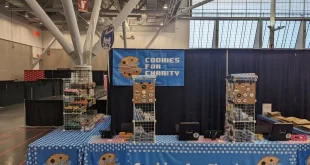It sounds like a simple enough game: everybody plays cards in ascending or descending order of size of the object on the card. A cat fits in a shopping cart, which fits in an office building, which fits inside a capital. Players make a long string of cards until they can’t top the last card, and the player who went last wins that run. The game needs two to six players, takes 20 or 30 minutes for a round, and is suggested for 10 and up. Nothing much to it.
Except, some of the cards are abstract terms.
How big is Pain? What size could one call a Mystery? Is Time larger or smaller than a Watch? On the one hand, a watch shows the time. On the other, time is transcendent of all human history. Mind-blowing.
Other cards have vague terms, such as Ice. Ice goes in a glass for cooling drinks, of course, but it could also mean all of the ice contained on the surface of the Earth. It could be whichever the player wants.
In A Pickle’s rules state, “You are encouraged to stretch your imagination and think outside the box.” What that quickly turns into is, “BS as much as you possibly can.” The cards bring a mix of luck, but the real skill of the game is to come up with as many crazy ideas as other players will allow. If someone calls a challenge to the play of a Diamond being bigger than a Bucket, the explanation is that it means one of the hypothetical deep-mantle diamonds the size of a truck. All the players vote, and if the BS convinces the majority of them, the card plays.
One example of this BS is that Paradise is larger than the Universe, Paradise being eternal while the Universe will eventually implode. Another is that Paradise is smaller than a Parking Lot, because true Paradise is nothing more than a perfect parking spot. Creativity is the key.
In A Pickle is a great kids’ game. It’s simple enough to be appealing to young minds, but expansive through creativity to make playing fun. The game was listed in Dr. Toy’s 10 Best Games of the Year as well as won a Creative Child Magazine Preferred Choice Award.
What I propose, however, is not that kids, but rather older folks pick up the game. With the right collection of thought-provoking players, the game is a riot. Cockamamie arguments come up with everything from Galactic Wormholes to philosophical discourses on religion to references to the storage locker at the end of Men In Black II.
I tested the game with a group of my friends who had an average education of grad school. Midway through, I laid the card Wood on top of the one Fire. My friends immediately objected. “Wood isn’t bigger than a fire! Fire consumes wood, so it has to be larger. I consume a burger, and so I am bigger than a burger.”
“No, no,” I told them. “We can’t look at fire as the ancient element, which it’s not. Fire is really the violent chemical reaction from the breakdown of molecular bonds. Now, because the wood has a higher energy state than the resulting ash and carbon dioxide, that is how we must count it as larger.” They had to give it to me out of sheer guts in genuinely supporting such an argument.
While the game isn’t perfect (much of it depends on the luck of the draw), it’s a great party game. I would suggest taking a pen to some of the more repetitive cards and adding new topics like “The Fourth Dimension” or “Fascism.” The rules encourage creativity already, so why not take it to the next level?
After all, how many games propose the Lewis Carol-type riddle of “How is a doorway larger than a thought?”
 Blogcritics The critical lens on today's culture & entertainment
Blogcritics The critical lens on today's culture & entertainment



